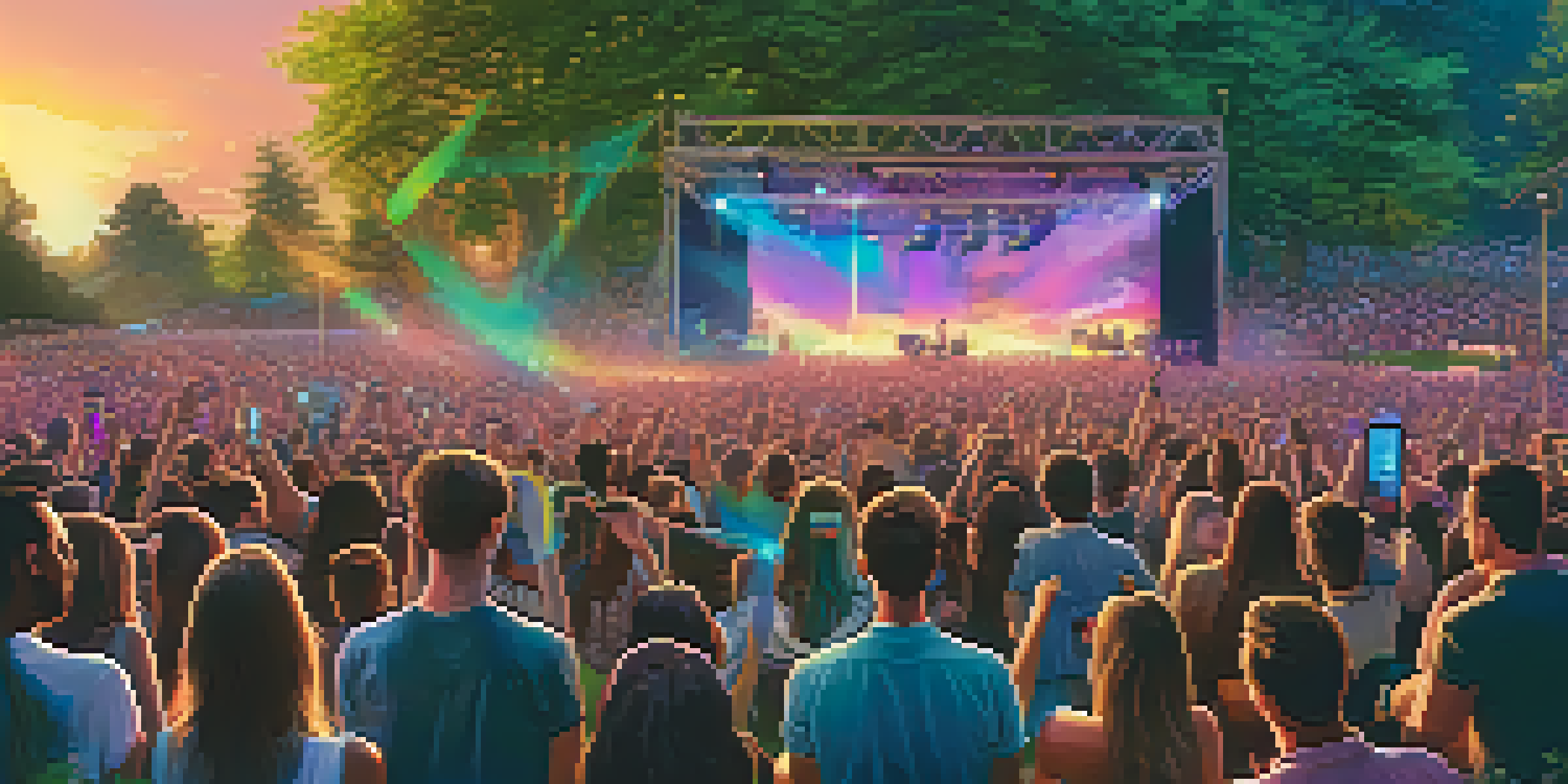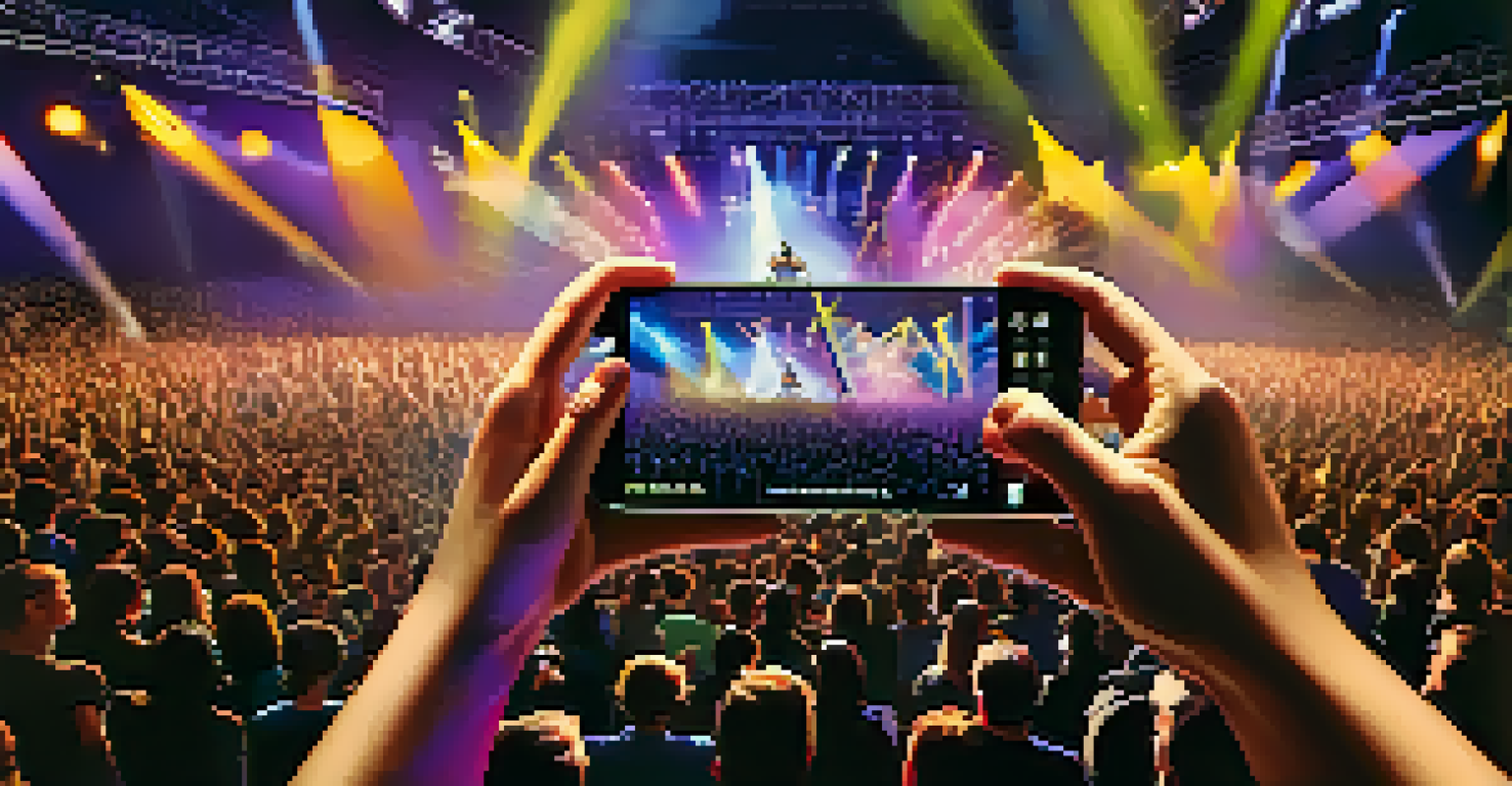AR and VR in Music: Creating Interactive Concert Experiences

The Rise of AR and VR Technologies in Music Events
Augmented Reality (AR) and Virtual Reality (VR) are revolutionizing the music industry by creating immersive experiences that captivate audiences. These technologies allow fans to engage with their favorite artists in ways that were previously unimaginable. Instead of just watching a performance, attendees can feel like they are part of the action, whether they're at home or in a venue.
The future of live music is not just about the artists on stage, but about creating experiences that allow fans to feel a part of the performance, no matter where they are.
Imagine attending a concert where you can see holographic images of your favorite band members performing right beside you, all from the comfort of your living room. This shift isn't just about convenience; it's about expanding the reach of music to audiences who might not have access to live events. With AR and VR, the barriers of distance and cost begin to dissolve.
As these technologies continue to develop, we can expect even more innovative ways to experience music. From interactive visuals to personalized soundscapes, the future of concerts is set to be more engaging and memorable than ever before.
Creating Immersive Concert Experiences with AR
AR enhances live performances by overlaying digital content onto the physical world, creating a richer experience for concert-goers. For instance, an artist might use AR to project stunning visuals that sync with their music, adding layers to the live performance. This interaction not only entertains but also deepens the emotional connection between the audience and the artist.

Fans can use their smartphones or AR glasses to see additional graphics, lyrics, or even behind-the-scenes content during a show. This type of engagement keeps the audience involved, making them not just spectators but active participants in the concert experience. It’s like having a backstage pass right in your hand.
AR and VR Transform Concerts
Augmented Reality (AR) and Virtual Reality (VR) create immersive experiences, allowing fans to engage with artists in unprecedented ways.
Moreover, AR can transform mundane venues into vibrant, interactive spaces. By utilizing local landmarks or themes, artists can create unique experiences tailored to specific locations, enhancing the overall atmosphere of the concert.
VR Concerts: A New Frontier for Music Lovers
Virtual Reality takes the concept of concerts to a whole new level, allowing fans to step into a fully immersive digital environment. With VR headsets, users can feel as though they are actually present at a live show, surrounded by fellow fans and the artist. This technology breaks geographical barriers, making concerts accessible to anyone with a headset.
Virtual reality is the next best thing to being there. It brings fans closer to the music and the artists they love.
One of the most exciting aspects of VR concerts is the ability to create entirely new worlds where anything is possible. Imagine attending a concert in a fantastical landscape or a futuristic city, all while enjoying your favorite music. This not only makes the experience visually stunning but also adds a layer of creativity that traditional concerts cannot match.
Additionally, VR concerts can offer interactive elements, such as the ability to choose different camera angles or to engage with the performance in real-time. This level of involvement transforms the passive act of watching a concert into an active experience, where every viewer can tailor their concert experience to their preferences.
Enhancing Fan Engagement Through Interactive Features
Both AR and VR technologies provide unique opportunities for fan engagement that traditional concerts simply can't match. Features such as live polls, Q&A sessions, and the ability to interact with digital avatars of artists create a sense of community among fans. This interaction fosters loyalty and deepens the connection between artists and their audience.
Imagine being able to vote on the next song an artist should play during a live virtual concert. This kind of engagement not only makes fans feel valued but also enhances their overall concert experience. It's like being part of a collaborative performance where every voice counts.
Interactive Features Boost Engagement
AR and VR technologies enable unique fan interactions, such as live polls and Q&A sessions, fostering a sense of community and loyalty.
Moreover, these interactive experiences can lead to increased social sharing. Fans are more likely to share unique moments from an AR or VR concert on social media, amplifying the reach of the artist and building a larger community around their music.
The Benefits of AR and VR for Artists and Creators
For artists, AR and VR offer a new canvas to express their creativity and connect with fans. These technologies allow musicians to explore innovative ways to present their work, thereby enhancing their artistic brand. Artists can create unique visual narratives that complement their music, providing a multi-sensory experience that resonates with audiences.
Additionally, AR and VR concerts can provide new revenue streams for artists. With the ability to host virtual shows, musicians can reach a global audience without the logistical challenges of physical tours. This opens up opportunities for monetization through ticket sales, merchandise, and exclusive content.
Furthermore, these technologies allow for more frequent performances without the physical toll of touring. Artists can engage with fans more often, keeping their music fresh and their connection strong, all while exploring creative new avenues for their artistry.
Challenges and Limitations of AR and VR in Music Events
Despite the exciting potential of AR and VR in music, there are still challenges that need to be addressed. One major concern is the accessibility of the technology. Not everyone has access to VR headsets or high-speed internet, which can create a divide between fans who can experience virtual concerts and those who cannot.
Additionally, creating high-quality AR and VR content can be costly and time-consuming. Artists and event organizers need to invest in the right technology and expertise to deliver engaging experiences, which may not always be feasible for smaller acts. This can potentially limit the reach of these innovative experiences.
New Opportunities for Artists
These technologies offer artists innovative ways to present their work and additional revenue streams through virtual performances.
Moreover, there’s the risk of oversaturation. As more artists jump on the AR and VR bandwagon, it’s crucial to ensure that experiences remain unique and engaging. If not, fans might become desensitized to these technologies, diminishing their impact on the concert experience.
The Future of Concerts: Blending Physical and Digital Realms
As AR and VR technologies evolve, the future of concerts looks promising, with a blend of physical and digital elements. We may see hybrid events where live audiences are joined by virtual attendees from around the globe, creating a more diverse and inclusive atmosphere. This combination can redefine what it means to attend a concert, making it a truly global event.
Additionally, advancements in technology may lead to more accessible and affordable AR and VR experiences for fans. As these tools become more mainstream, we can expect to see a wider range of music genres and artists utilizing them, enriching the overall landscape of live music.

Ultimately, the integration of AR and VR into music concerts represents an exciting shift in how we experience art and entertainment. By embracing these technologies, artists can create unforgettable experiences that resonate with fans, ensuring that the magic of live music continues to thrive in this digital age.